There are lots of kinds of beehives, but many of them have the same construction: a brood box, which is a large space for the colony to live, and supers, which are smaller boxes, added on top, in which bees make honey and which beekeepers sometimes have to take away for their own good (the beekeepers' own good, not the bees').
Bees need a certain amount of space (or rather, surface area on which to build comb), so the brood box is often a certain size, large enough for the colony to live in. This means that the frames are large and can become very heavy when full. This isn’t a problem, as most of the time frames are only lifted one by one for inspection. Supers tend to be smaller, as they are removed as a unit (containing about 12 frames), and honey’s actually quite heavy.
Bees aren’t naturally given to live in one part of the hive and put honey in another part. It’s usually all a bit mixed up, with stores (honey and pollen) and brood (eggs and larvae) on the same frame. The queen excluder is placed between brood box and supers to keep the queen, and therefore the eggs, out. This isn’t natural, but it makes the whole honey business easier and they don’t seem to mind.
(Interestingly, I recently found out that workers (who are female) can, and do lay eggs. Workers aren’t quite the right shape, and don’t have the self-control that the queen does, so they end up laying more than one egg at once, and along the walls, not the base of the cell. This is generally frowned upon, so other workers come along and EAT THEM.)
When I aquired the hive I bought a brood box and three supers, which was purely guesswork, but, I thought, about the right balance of equipment vs cost (it isn’t cheap to get set up, there are lots of bits and pieces to procure). When I bought the nucleus, I was advised that this strain are happiest with a brood box and a half. This means using the brood box and one super for the brood to live in, an the queen excluder on top of that.
Elbow room
Last week, I decided that I’ve given my bees long enough to settle in, and that I’d do an inspection. They were coming along well, and had gone a good way toward drawing out wax from the new foundation and filling it out with stores and brood. Foundation wax comes as sheets with the hexagonal pattern imprinted on it.
They had clearly decided that a couple of frames of the southern end of the hive weren’t worth inhabiting (or maybe they just hadn’t found it yet) but were filling up the bits they could find at a great pace. The bees might have decided not to use that comb and then felt cramped. I thought that I would probably have to give them extra space sooner or later, and I might as well do it now, as I had the hive open.
So I added the extra box, expecting them to ignore it, and gave them a week.
A week later
I opened up my hive a week later. The new combs were full of the most perfect, new, pristine comb. I like to hope that the bees were at least a little bit proud.

They hadn’t done it all. There were a couple of frames in which they had started. These were a snapshot in time of the construction of comb. You can see the hexagon-stamped foundation wax with billows of drawn comb rising up.

Rather, down, as the frame is upside-down. In the wild, bees start making comb attached to something (like a branch) and build it downward.
Not only had they created gorgeous new comb, but they’d already put it to use. The queen had neatly laid eggs in four of frames (eight combs). If I zoom in on this picture:
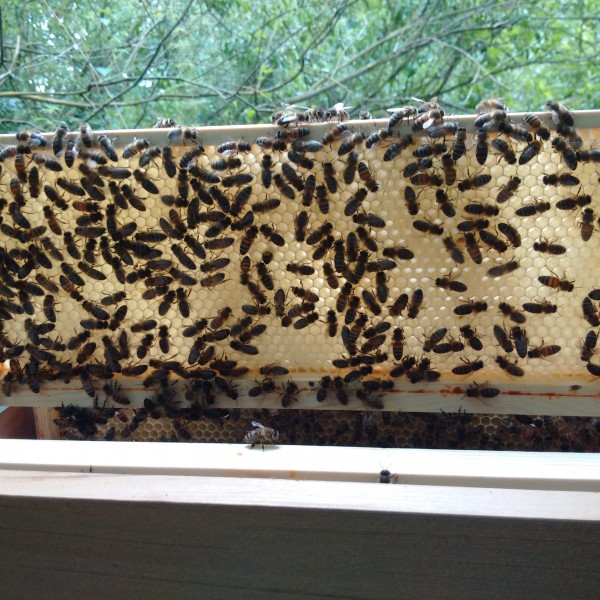
You can see the eggs. They’re very small, a couple of millimetres and they stand up from the bottom of the cell.

Eggs spend a day or so standing up, then lie down, become larvae for 9 days and then pupate. Going by their appearance, these eggs might even have been laid yesterday.
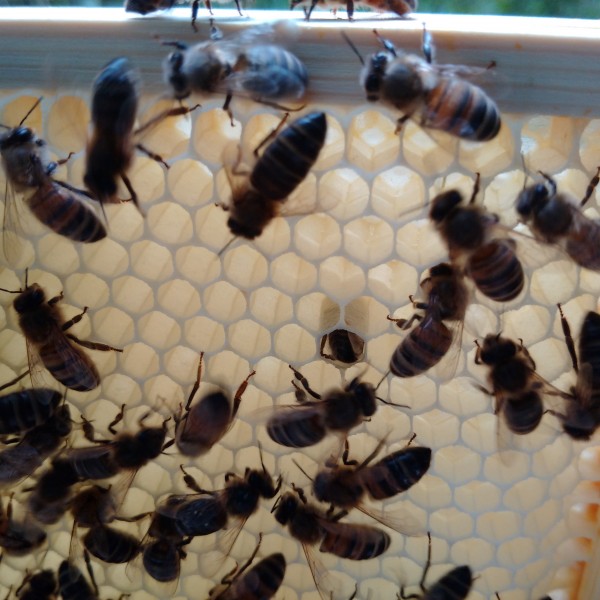
Storing things up
I found eggs in 4 out of 10 frames and stores in 8 (with some overlap). This is mostly the sugar syrup that I’ve been feeding them (they have been at liberty to forage real nectar from flowers). I was very careful with that, as it was still very fluid. When this has evaporated a little and the water content is a bit lower, it will have become honey and they will cap it for use later on.
A shakeup
I also had a proper look at the brood box. My bees are still reluctant to use the south-side of the hive, which means that frames go wasted and they don’t have as much space to work with as they could.
So I shuffled the frames round a bit.
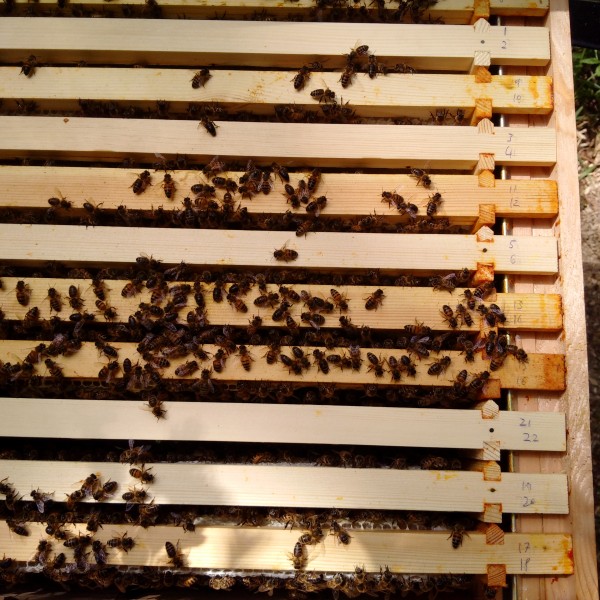 Hopefully not enough to confuse them, but enough to make them realise that they’d missed a bit. Same in the top part.
Hopefully not enough to confuse them, but enough to make them realise that they’d missed a bit. Same in the top part.
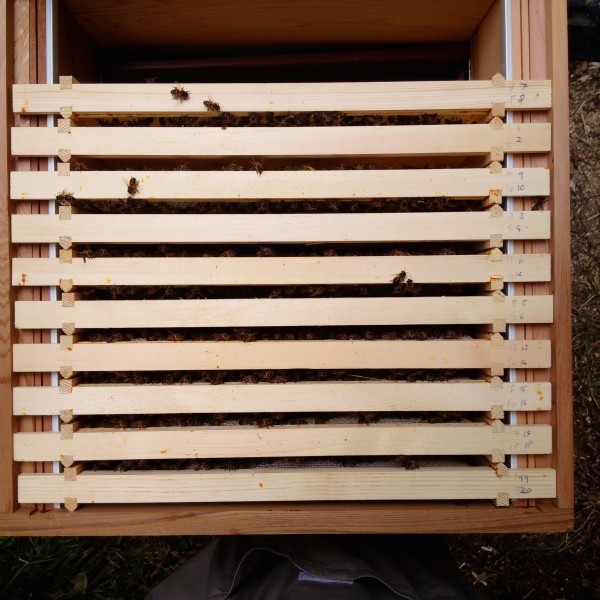 For those of you wondering about the gap, I misremembered how many frames a hive could hold and only made 10. I have another two waiting.
For those of you wondering about the gap, I misremembered how many frames a hive could hold and only made 10. I have another two waiting.
Same old
Otherwise the inspection of the brood box was normal. Lots of capped brood. There was lots of capped brood last time, which means that some of these bees are probably only a couple of days away from emerging from their cells.
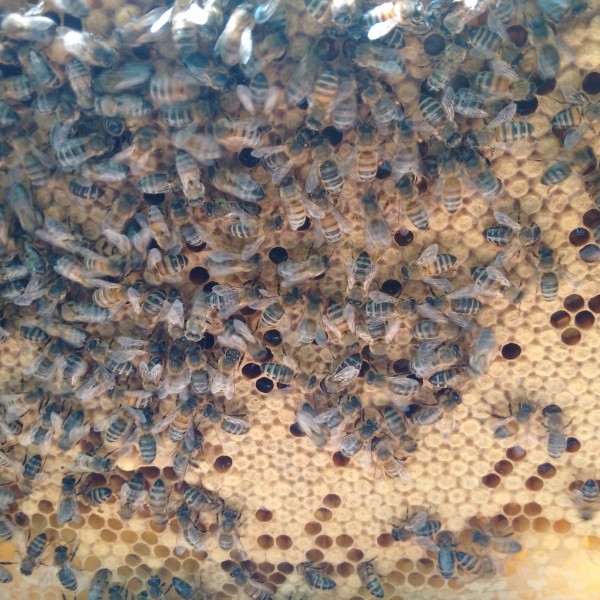
And I saw the queen, which is always nice.
I wish I’d been able to get a photo of her, but things became awkward. The bees started to become inquisitive toward the end of the inspection. They were immaculately well behaved, not the slightest hint of aggression, but they started climbing all over my hands. Have you tried handling a comb, covered in bees, while the tips of your fingers are covered in bees? And then trying to put the comb back with all the bees in the wrong place so you can’t put it where it’s meant to go and it’s a bit too heavy to hold with one hand?
A metaphor for something, probably.
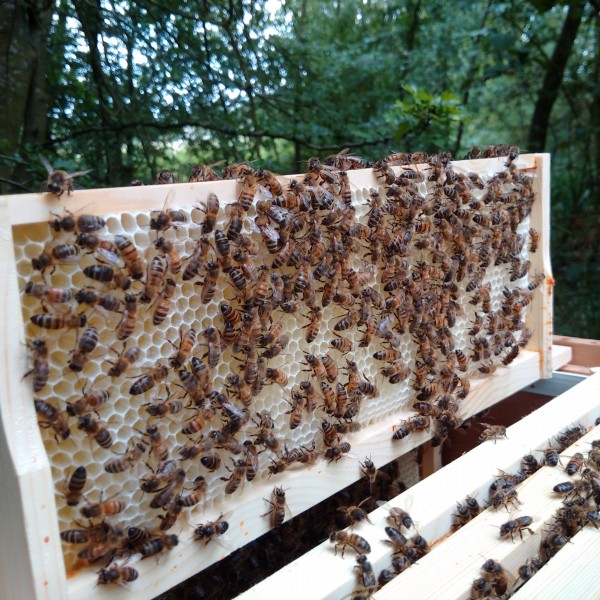
Read more about my bees.
(for those of you who know what you’re talking about, this happened in August)